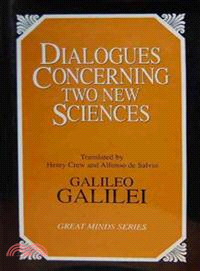Dialogues Concerning Two New Sciences
商品資訊
系列名:Great Minds Series
ISBN13:9781573920810
出版社:Random House Inc
作者:Galileo Galilei; Henry Crew (TRN)
出版日:1991/06/01
裝訂/頁數:精裝/298頁
定價
:NT$ 608 元無庫存,下單後進貨(到貨天數約30-45天)
下單可得紅利積點:18 點
商品簡介
作者簡介
相關商品
商品簡介
Galileo Galilei was a great scientist, and therefore not afraid of causing controversy, even if he had to pay a great price. This book deals with motion and the resistance of solids. It is the summary statement of a life devoted to scientific experimentation and free inquiry un-trammeled by tradition and authority.
作者簡介
GALILEO GALILEI was born in Pisa on February 15, 1564, into a family of impoverished nobility. In 1581 he enrolled at the University of Pisa to study medicine, but later abandoned this for mathematics. Galileo was appointed chair of mathematics at Pisa, and remained in that post until 1591; later he moved to Padua, and finally to Florence.
In marked contrast with the established tradition of science, Galileo relied on experimentation rather than ab-stract theorizing about the operation of the physical uni-verse. The famous experiment conducted from the top of the leaning tower of Pisa demolished the Aristotelian dictum that objects fall with a velocity equal to their weight. Galileo's avowal of the Copernican theory of the solar system, which set the sun and not the earth at the center, put him at loggerheads with ecclesiastical authority. Galileo was denounced publicly by the clergy and his peers; following the publication of his Dialogue Concerning Two Chief World Systems in 1632, Galileo was brought before the Inquisition for heresy and ordered to recant. The Inquisition subsequently decreed that all copies of the Dialogue be burned and that Galileo be imprisoned for the remainder of his life. The sentence was later commuted to house arrest at Arcetri, outside Florence.
Despite its suppression in Italy, the Dialogue Con-cerning Two Chief World Systems was translated and disseminated throughout Europe. Galileo likewise became known for his discoveries of new heavenly bodies and refinements of the telescope. His last work, Dialogues Con-cerning Two New Sciences (1638), completed while under house arrest and smuggled out of Italy, deals with the motion?and resistance of bodies. Galileo regarded the Two New Sciences as the best of all his studies. Indeed this work, the result of more than thirty years' experimentation and labor, may stand as the greatest monument to a life devoted to scientific truth and defiant of all strictures on freedom of expression. Galileo died at his villa in Arcetri on January 8, 1642; coincidentally, the year of his death is the year Sir Isaac Newton was born.
Galileo Galilei's other published works include Sidereus Nuncius (Starry Messenger) (1610), on the revolution of heavenly bodies; and Letters on Sunspots (1613).
In marked contrast with the established tradition of science, Galileo relied on experimentation rather than ab-stract theorizing about the operation of the physical uni-verse. The famous experiment conducted from the top of the leaning tower of Pisa demolished the Aristotelian dictum that objects fall with a velocity equal to their weight. Galileo's avowal of the Copernican theory of the solar system, which set the sun and not the earth at the center, put him at loggerheads with ecclesiastical authority. Galileo was denounced publicly by the clergy and his peers; following the publication of his Dialogue Concerning Two Chief World Systems in 1632, Galileo was brought before the Inquisition for heresy and ordered to recant. The Inquisition subsequently decreed that all copies of the Dialogue be burned and that Galileo be imprisoned for the remainder of his life. The sentence was later commuted to house arrest at Arcetri, outside Florence.
Despite its suppression in Italy, the Dialogue Con-cerning Two Chief World Systems was translated and disseminated throughout Europe. Galileo likewise became known for his discoveries of new heavenly bodies and refinements of the telescope. His last work, Dialogues Con-cerning Two New Sciences (1638), completed while under house arrest and smuggled out of Italy, deals with the motion?and resistance of bodies. Galileo regarded the Two New Sciences as the best of all his studies. Indeed this work, the result of more than thirty years' experimentation and labor, may stand as the greatest monument to a life devoted to scientific truth and defiant of all strictures on freedom of expression. Galileo died at his villa in Arcetri on January 8, 1642; coincidentally, the year of his death is the year Sir Isaac Newton was born.
Galileo Galilei's other published works include Sidereus Nuncius (Starry Messenger) (1610), on the revolution of heavenly bodies; and Letters on Sunspots (1613).
主題書展
更多
主題書展
更多書展今日66折
您曾經瀏覽過的商品
購物須知
外文書商品之書封,為出版社提供之樣本。實際出貨商品,以出版社所提供之現有版本為主。部份書籍,因出版社供應狀況特殊,匯率將依實際狀況做調整。
無庫存之商品,在您完成訂單程序之後,將以空運的方式為你下單調貨。為了縮短等待的時間,建議您將外文書與其他商品分開下單,以獲得最快的取貨速度,平均調貨時間為1~2個月。
為了保護您的權益,「三民網路書店」提供會員七日商品鑑賞期(收到商品為起始日)。
若要辦理退貨,請在商品鑑賞期內寄回,且商品必須是全新狀態與完整包裝(商品、附件、發票、隨貨贈品等)否則恕不接受退貨。
























